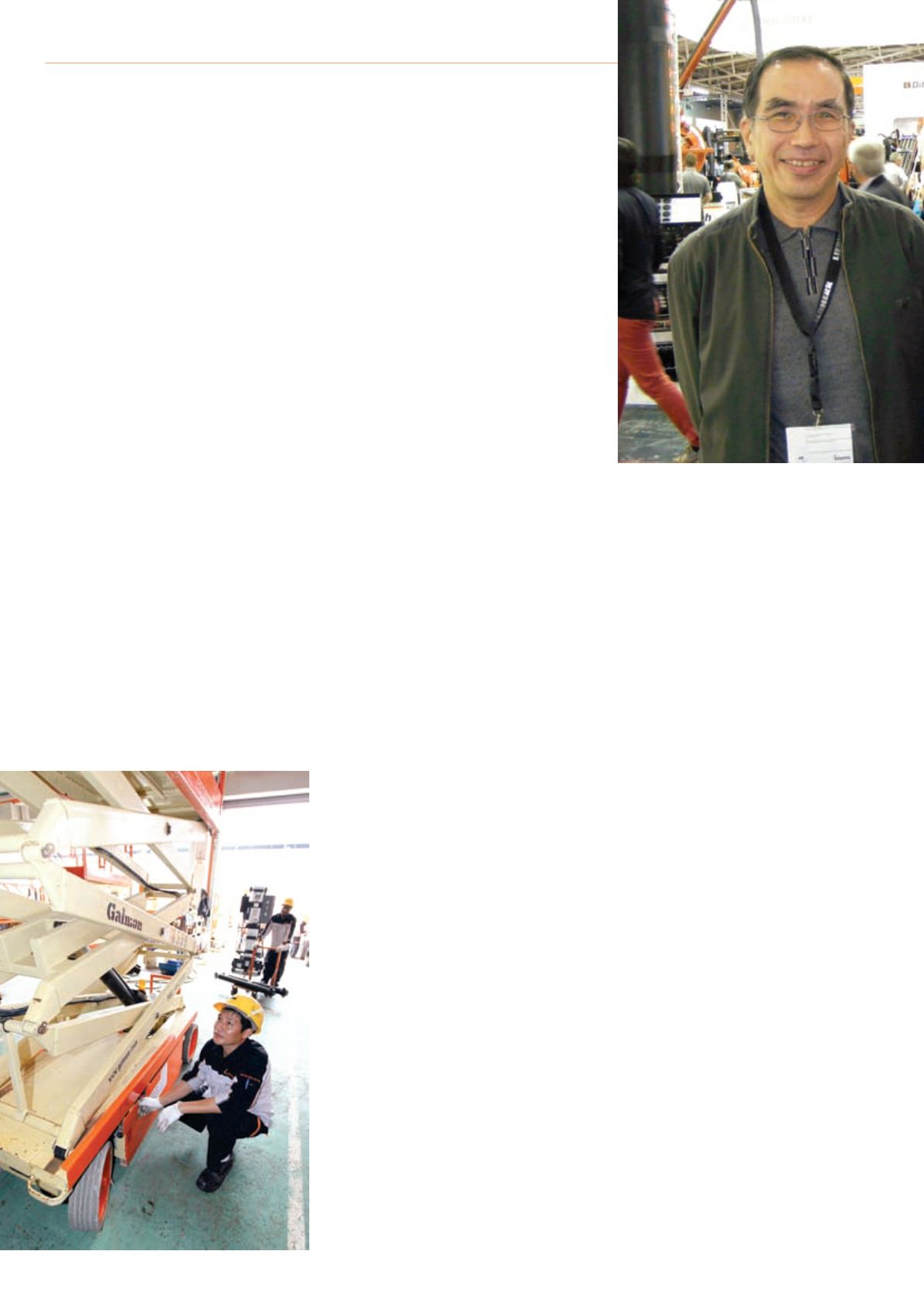
INTERVIEW
10
access
INTERNATIONAL
MAY-JUNE 2013
rental company of its type in Asia, but mainly
as a result of its mission to spread better
working practices across the industry.This
represents a tough challenge, as the country
is only just adopting working at height
standards, while the rest of the ASEAN
Region is far behind with lower labour costs
and an almost non-existent access market.
The company boasts a fleet of some
2,700 units, comprising a complete range
of equipment, the vast majority of which
are JLGs. Mr Ong puts the total number of
AWPs operating in Singapore at near enough
9,000 units.
Galmon has also been a distributor for
JLG in Singapore since 1993, before which it
specialised in machines from Mark Industries.
Its compact tracked and wheeled units have
been supplied by TCA for the last 15 years,
while vehicle-mounted lifts come from
Versalift & GSR.
“We used to cover more areas around
Singapore for JLG, but it has set up its own
dealerships in the region, so it’s kind of
restrictive for us to sell machines there.” Now,
the company is based firmly in Singapore, but
does have an office in Malaysia.
Heightening standards
In the absence of its own standards, Singapore
importers have tended to recognise CE,
ANSII and JIS ( Japanese Industrial Standard)
approved machines. “We predominantly adopt
the ANSII standard, about 99% of machines,”
says Mr Ong, “except Haulotte, which is using
CE to come to Singapore.”
Times are changing, however, in Singapore.
The new Workplace Safety and Health
(Work at Heights) Regulations have been
written into law by Singapore’s Ministry of
Manpower. It is coupled with the Code of
Practice for Work at Heights, both being
S
ingapore has seen some major changes
over recent years and is now a saturated
market surrounded by countries
that have little or no rental to speak of. It is
also seeing stringent new standards being
introduced, which will greatly affect the many
small companies that are operating with little
safety awareness and old, outdated equipment.
Meanwhile, Galmon is the biggest provider
of AWPs in the country and South East Asia,
and prides itself on working at a world class
safety level.The company was founded in 1982
by Desmond Ong, who continues to lead the
company as its CEO.
Mr Ong describes Galmon as a pioneer in
the access sector, partly because it was the first
introduced at the beginning of May this year.
The code of practice was originally set up
in 2006 following a large number of accidents
but only addressed general construction.
“They have now split construction and
working at height apart.The government
has been bending strongly toward this since
2006 because of the fatalities from working
at height,” explains Mr Ong. “Our Prime
Minister Lee Hsien Loonghad set Singapore a
target of 1.8 fatalities per 100,000 by 2018; so
that is a huge milestone.”
It is the disparity in quality of aerial work
platforms working in Sinpapore that has partly
encouraged the new regulations. One of the
causes of this influx of machines, some of
which were sub-standard, was the introduction
in 2008 of large-scale government projects to
bolster the construction industry.
“At that time 90% of the machines in the
country were being used, and we know that
there were a lot of new companies coming into
the sector,” explains Mr Ong, “And due to the
recession in the US, there was an abundance
of used machines there. Many of them were
brought into Singapore, and the quality is
now questionable.The choice is; you can
have a great machine used by one of the best
companies, or auction pieces which are junk.
“In 2010, after the major projects had
finished, utilisations went down 50% - not just
for us but for everyone. For companies from
oversees this was alright because they just
shipped the units out of Singapore.”
As a consequence, rental rates have dropped
from that peak period by 40% to 50%. “But
fortunately our utilisation rate is now not
too low because we had customers that were
always loyal to us.”
During this difficult period Galmon kept its
fleet mostly intact, and even had a programme
of expansion, “We measured the fall, we did
not get rid of a load of machines.”
Mr Ong continues, “Rates are not actually
the issue. When the rate has gone down, it
Taking
steps
The powered access market in Singapore, and the
surrounding region, is on the cusp of reinvention.
Desmond Ong, CEO of the country’s biggest rental
company Galmon, explains all to
Euan Youdale
One of Galmon’s scissor booms,
manufactured by JLG


